‘Blue My Mind’ and New Female Monsters
Boasting an innate reluctance to identify with patriarchal familiarities and transcending the body from a warm-blooded house to one that craves relief from hormonal tragedies have been inherent devices used within cinema for decades. Coming-of-age films have amalgamated with the horror genre to seek a purifying cleanse from the abhorrent cruelty that forms within the body during this time, as evidenced by the critical successes of Julia Ducournau’s Raw (2016) and Karyn Kusama’s Jennifer’s Body (2009). Albeit exaggerated to a bestial transgression, horror is known for stripping away solidified social hegemonies in the pursuit of revealing monstrous resurrections. Lisa Brühlmann’s coming-of-age body horror Blue My Mind (2017) marries the cisgendered female body with an uneasy visceral repugnance that redefines what it means to be ‘the other’, and to rebirth the monstrous feminine’s intrinsic flow.
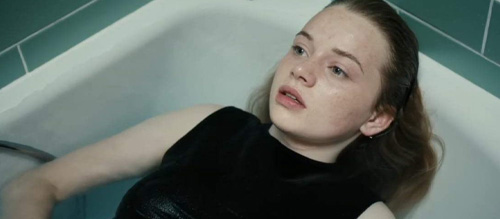
The creature, particularly one associated with the mermaid or the siren figure, acquires attention for the symbolic furnishing of biological anomalies. Tails, scales, webbed limbs, and fins ring unfamiliar, acting as bait for an involuntary fascination with the obscure. Accompanying these abject features is a reaction of both allure and disgust, and when such material is presented alongside the figure of an already evolving body a spectacle of attraction is established.
Blue My Mind tells the story of Mia (Luna Wedler), a teenage girl who begins to question her own identity as she slowly transforms into a mermaid. The first introduction to Mia is one of immediate depression – she gazes longingly out the window of her newly moved-in house, staring at the construction site laid before her. Leading on from this is continued trepidation as her first day at her new school refuses to flow smoothly. The classroom is brimming with distracted teens who put on a show of bravado to impress the opposite sex, and the micro hierarchical structures of high school only continue into the playground with one girl precariously dancing in front of a group of boys as they gaze at her prowess. However, something is different about this girl, something stands out, especially to Mia. Gianna (Zoë Pastelle Holthuizen) is bolshy and conceited, questioning Mia for even daring to speak to them. This initially brief involvement of Gianna’s allurement catalyses an insatiable desire to be awakened within Mia; one that is confronted with the positioning of idealised femininity in an eschewed light.
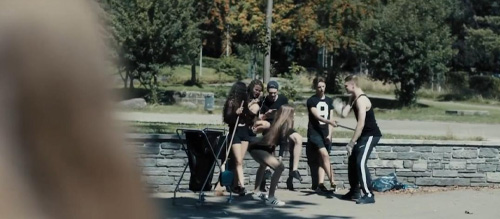
The natural changes occurring in a teenage girl are heavily rooted in abjection, arresting us through forcing an experience where gratification in sensationalised taboos is deemed acceptable to view. The abject evokes society’s lust for otherness – no matter how grotesque there is a generalised curiosity for absurd material – and thus a unique bond is manifested between screen and viewer. Mia’s interaction with a feeling previously unfelt, being subjected to Gianna’s ambiguity, provokes the beginning stages of metamorphosis. After their brief encounter, Mia returns home and lashes out at her mother, even going so far as to push her to the ground in rage with a newfound strength. Even her father’s scolding does not trigger an apologetic response. Instead, Mia is distracted, ogling over the fish tank.
Seemingly, Mia no longer holds the patriarchal status of being ‘daddy’s little girl who wouldn’t dare stray’, which is furthered by her induction day with the popular crowd. After showing off on the outskirts of the school, Mia is invited to hang out with Gianna and her ragtag group of fake friends. Whilst they spend their time gloating about their sexual conquests, an unconventional game breaks out where they grip one another’s neck with enough force to induce a momentary blackout. At first, their unusual pastime aims to garner a reaction of shock and fear from Mia, proving that she’s not cool enough to hang with them, yet her willingness to feel ‘something’ other than her strange impulses starts to take over as she surpasses their expectations by blacking out for a second too long. From here, Gianna knows that Mia is not like the rest. In fact, she’s not like anyone she has ever met. Thus starts a lingering desire between the two that exceeds friendship and enters a deeper territory.
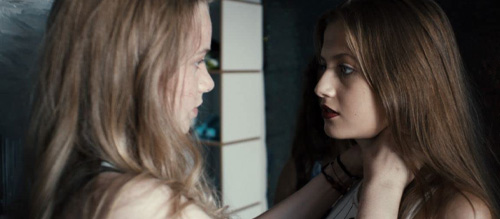
The treacherous bonds between Mia’s parents and herself, along with the hypersexualised meeting with Gianna, synchronises coming of age with otherness, bluntly suggesting that her body has become a weapon capable of going beyond the norm all in thanks to disavowing pathological ideologies within the female form. She wants to linger at other girls’ bodies; she wants to experience the chokehold of a dominant touch, and she wants to officially abandon the one aspect that is holding her back from being a ‘woman’: her virginity.
The days following these incidents reveal an underlying famine provoked by Mia’s freakish changes. She has been repressing the urge to massacre the family fish tank by gulping down glasses of saltwater, but this containment can only last for so long. The first step downhill occurs when she plunges her fist into the fish tank and greedily gnaws on a live goldfish. Although the scene ends in a regurgitation of the meal, a gleam of relief and unsure satisfaction beams from her scared reflection. This is it. It’s too late to turn back. Mia is sinking into her true identity as a mermaid. This incarnate purging is an introduction to what the future beholds. Now that she has tiptoed into monstrous realms, it becomes appropriate for Mia to nosedive into the next phases of transition. Going shoplifting, meeting older men for sex, experimenting with boys, drinking, and drugs, are the result of Gianna’s influence over Mia. Whilst the reckless anarchy at first is an exciting prospect, it unravels Mia’s psyche, her rather normal practices become a punishment as her toes begin to meld together (creating a webbed surface) and strange, painful bruises begin forming all over her legs. The female body is a tool, a folklore-styled tale that acts as a warning to prepubescent girls that they mustn’t misbehave or else their own body will betray them through bleeding, secreting, aching, and growing. Now that Mia has metaphorically let her hair down, she has reached menstruation and is being rebelled by her own flesh.
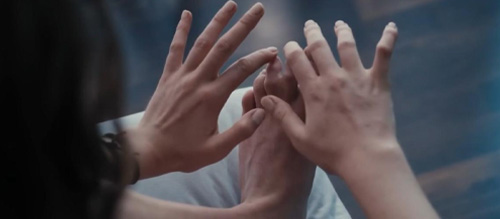
Predominately, within the condition of the monstrous feminine, a natural yearning for sexual exploration is devoted to the body, particularly whilst her monstrous form is excavated from the inner psyche to a metaphysical state. This is apparent in traditional monstrous feminine cinema such as The Hunger (1983), in which Miriam (Catherine Deneuve), a lustful vampire, coincides her taste for blood with her sexual expression, in turn causing destruction and death to those she cares for through sinking her vampiric fangs into their bodies to appease her vivacious appetite. Whilst the mystifying nature of vampires is at the focus point in The Hunger, the film more advertently caresses the link between the female body and fear. Miriam’s curves and immortal ferociousness lure people in, tempting their arousal, only for this same attraction to ensure their demolition. The stark contrast between the normal female form and one of otherness is not a giant leap. Rather misogynistically, women are seen as objects where their position is situated around men’s needs, Miriam understands these rulings and uses them to her own advantage, somewhat seducing her prey when they are at their most vulnerable state, resulting in an easy feast. This entire notion of women using their bodies to lower men’s habitual place in society is the exact thought process behind the monstrous feminine theory. In principle, women are scary because they have the equipment to alter the solid symbolic order.
At no other point is this power stronger than when a female is in the process of transforming from an innocent girl to a woman who bleeds, craves intimacy, and more importantly physically adapts into a traditional object of carnal passion. For decades, coming-of-age cinema has enacted that familiar expression of body modification that forces the feeling of being out of place in the skin called home for years. Confusing and conflicting emotions are at war with one another during this time and coming-of-age dramas such as Fish Tank (2009) and Eighth Grade (2018) perfectly depict this internal struggle in a conventional manner through exploring the hardships of tackling the popularity contests in high school and dealing with awkward, even inappropriate crushes. However, what if this internalised crusade was personified through horror, a genre rife with dramatising real struggles? Configuring this burgeoning lust for release with an inescapable sense of power that burns deep inside of the pubescent figure is precisely Blue My Mind’s motive. Brühlmann feeds the yawning hole of underrepresentation that the horror genre has been fighting to upturn for years. Dark cinema is not a stranger to teen-based films – in fact, the genre thrives in using the adolescent figure as a tool for storytelling, with the likes of Cherry Falls (2000) and Urban Legend (1998) using high school students as the film’s focus characters – but an infatuation with the subject matter does not directly translate to correct or accurate testimonies of what it means to be a hormone-fuelled, stretch mark filled, oddly proportioned teenage girl.
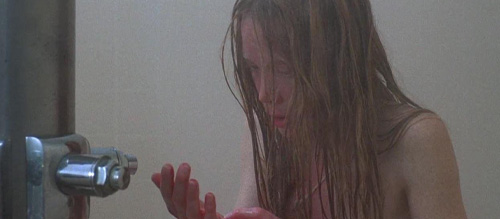
This chaotic journey that horror cinema has wrongly perceived as singular mainly began with Carrie (1976), a film that relishes in the perceived hysteria that comes with being an adolescent female, meaning that the progression into adulthood should be shown as lusty, something to fear, and dreadfully catastrophic. Brian De Palma’s declaration of womanhood on the edge of insanity was adapted from Stephen King’s 1974 book of the same name. Based on the sheer credits alone Carrie immediately derives from a source of masculinity. Whilst creative freedom is absolutely vital in art expression, and De Palma and King respectively are horror legends in their own right, Carrie meanders in waves of misogynist outlooks toward femininity. Unlike Mia’s journey to freedom and acceptance, Carrie (Sissy Spacek) spends the entire film unfolding her monstrous anatomy with bursts of violence, savagery, and mercilessness, almost as if violence becomes her personality, abandoning any sense of humanity, making it tedious to form a connection with the audience. The opening scene reveals the inside of a high school changing rooms filled with naked underage teenagers prancing around and revelling in their youth. The camera then pans to the showers, showing Carrie ‘innocently’ running soapy hands up and down her bare thighs with water trickling down, immediately presenting a suggestive gaze lulling the viewer into a state of transfixion. All of a sudden the view cuts to a close-up of worrying eyes as Carrie knows that something is different and feels an unknown sensation. Then it happens… De Palma reveals her blood-soaked fingers dripping crimson excess as she receives her period for the first time before turning the camera to reveal her peers’ reaction of laughter and disgust. Upon dissection, this scene acts as the omnipotent warning for the rest of Carrie’s woeful objectification; not only is the viewer invited to survey the nude body of the female adolescent as if this were a chance to taste the forbidden fruit, but the matter of Carrie’s menstruation is demonised and thought of as alien.
Over the course of the film, Carrie’s menarche is the sole turning point for her transformation into a literal monster. Her disenfranchisement from high school norms transforms from generalised anger over her bullying peers to a literal bloodbath as the film’s conclusion surrounds Carrie setting her school and fellow teens on fire, in what can only be described as an uncontrollable urge for vengeance. Alternatively, the angst felt by Mia in Blue My Mind as her world seemingly collapses around her is not considered conclusive to pure destruction to her surroundings. The threat her body poses is certainly drastic, but the way in which Brühlmann encapsulates her turmoil is a turning point for coming-of-age cinema that deserts archaic pastimes denoting teenage girls as emotive wrecks and dedicates the time to flesh out the harsh reality that comes with discovering one’s identity, not portraying a fantastical depiction of unimaginable chaos. Mia, like Carrie, may be a slave to her newfound urges, yet Mia stays in touch with a sense of purity and devotion to being free that challenges previous attempts at unfolding the female monster. Horror idolises the pain felt within the coming-of-age period. And, unlike previous efforts where the change of womanhood is told by a man who is unknowing and inexperienced in the subject, Blue My Mind is a relatable and earnest forcefield where a universal truth is spoken, both redefining and recontextualising this niche but powerful wave of cinema for the better.
As Blue My Mind develops, an overarching envelope of security is found deep inside of Mia. She knows that her eventual acceptance is the key to her freedom. This journey is a progressive step for Mia, but it is not without its hardships. As her ungovernable ways begin to discharge through the heedless drinking and partying, a realisation suddenly hits; Mia may be suffering at the hands of her own actions. However, each step towards becoming ‘the other’ is simply a disguised level on the ladder to her eventual liberation, thus thrusting Blue My Mind’s unique take on the cinematic teenager into an unmissable level.
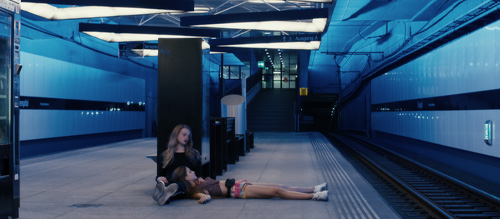
To experience a confrontation with corporeality soaked in the sheer emotional turmoil of adolescence rather than violence is gravely cruel. Mia’s naturalistic rebellion can be seen as a riot against the patriarchal order, with stealing items and underage drinking being genuine concerns. The debaucheries that Mia and the gang get up to are not glorified and speak true to the gritty journey that many youths face as drugs, alcohol, and cheap thrills are seen as coping agents to numb the pain. Mia’s involvement seems to drastically increase throughout the film, becoming more reliant on substances to ease her raw emotions. Films such as Blue My Mind and Catharine Hardwicke’s acclaimed Thirteen (2003) intercept teenage struggles with drug and alcohol dependence and rely upon honest retellings of what it means to be lost amidst a world where unique expressionism is disapproved of, meaning that audiences become acquainted with very real struggles in an otherwise fictionalised landscape that testifies a candid, intelligible storyline to provoke the viewer and leave a lingering mark of understanding upon them. Mia’s only relief is found within these charades, leading her moral compass to become shattered, and pure pandemonium to set in; particularly as the mysterious bruises on her legs begin to mutate into rotting skin that she delicately pulls off, resulting in gaping wounds weeping blood. The act of shedding skin for scales is a crude declaration of her powers. In order to feel relief, she rebels, but the more frequent these acts become, the more abhorrent her disfigurement emerges. It’s an endless cycle of torment.
As the monstrous feminine shape shifts within Mia, an allurement around her freakish nature attracts Gianna. The once-popular brat who was emotively untouchable relies on Mia for her sanity amidst the hazardous world of womanhood. One night as the clique goes about their routine bedlam antics, Gianna in a drunken haze falls into a lake and is left to drown. Mia witnesses the struggle and dives into the abyss, passionately kissing Gianna and pulling her to the surface. Just as Gianna’s expression paints one of admiration and pure devotion to her saviour, Mia rushes off in a distraught state knowing that this kiss was her own kiss of life. Now, Mia is left instinctually tapping into the reality that she’s been denying the whole time. The only moment that has scratched her itch to feel anything other than upsetting doubt occurred underwater with an unattainable being. In retaliation to the inevitable, Mia runs amok on a path to destruction, angry at her bodily changes and diminishing humanness. Another futile party situates Mia in a fatal position as she ends up in a room with a group of unknown men who take advantage of her disorientated state in the hopes of gang raping her. The men stand tall forming a circle where Mia lies below them, waiting to feel physical pain to disguise her psychological agony. The group’s lingering stares dominate the mood as they begin to pass Mia around like an object before Gianna rushes in to save Mia from her ill fate. To still get their kick from the situation the men begin to aggressively rip Mia’s clothing off to hurry the deed, but their perverted gaze dramatically shifts to one of utter disgust as Mia’s bare body reveals entwined toes, sallow skin, growing gills, and flaky scales. Her condition is put on display for everyone to gasp and wretch over as if she is the prime exhibit in a freakish museum.
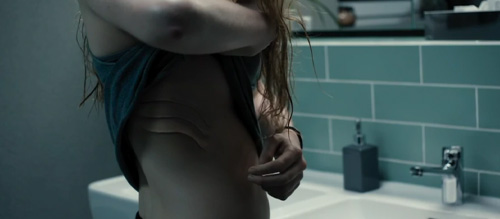
Throughout, Mia has been shown behind closed doors becoming increasingly disturbed over her bodily revision, panicking and crying over every grotesque mark, patch of discoloration, and slits embedded in her skin. Due to the men’s actions, her secret is now out, forcing her to parade her new physique. At this party the veil between her condition and the world is involuntarily ripped apart in a derogatory and cataclysmically embarrassing manner; rather deliberately the men in this scene are shown to be stimuli to Mia’s final stages of metamorphosis. The lack of consent they abuse, and their predatory glares, all associate their actions to be animalistic, akin to a bestial primality that corresponds with Mia’s subhuman qualities.
During the mass assault against Mia, her monstrosity has grown from the previous scenes (before she did indeed have an excess of abnormalities forming), but this event mimics a booster shot that surges her subjectivity from horrid to extremely abysmal. Here, Brühlmann’s modus operandi is prominent – Mia’s humanoid evolution is triggered by her natural journey into womanhood, yet unlike Carrie where menstruation is a death sentence, Blue My Mind refuses to bandage up the monstrous feminine as simply being adjacent to the menses. When Mia receives her period, her reaction is mellow compared to how she behaves upon glancing at her mermaid transformation; even further symbolising the natural discharge as entirely normal and malignant.
Alternatively, the vehicle for her otherness is found within the role of the ‘masculine’. Mia’s relationships with the men in her life (not singularly but also) play a significant role in her corporeal advancement. For example, when Mia’s father is lecturing about her aggressive stance to her mother, Mia refuses to listen and focuses on the fish tank, foreshadowing her future feast upon the family’s fish. Again, after Mia takes charge and has sex with one of her obnoxious classmates, her abdomen and legs scar with flurried purple veins and dark blue bruising. Mia’s monstrosity worms its way out of the surface at a faster rate once she has been either physically or emotionally penetrated by a man. Seemingly, her mermaid form has always doomed her fate, yet the tortuous elements blossom rapidly once she interacts with the men in her life. Mia’s only human companion at this rate is found in Gianna, a young woman who does not align with androgyny and fully embraces femininity in every way, nursing the film’s inclination that comfort is found away from the masculine and is found only within the feminine.
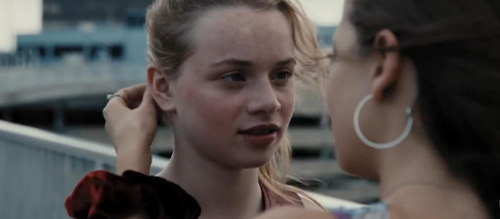
Blue My Mind socialises itself with the alternative subsection of monstrous horror. Within this alcove of distinct cinema, the array of rules founded within the likes of slashers (such as ordering the promiscuous character to a fatal end or positioning the ‘good girl’ persona to be the one to survive it all) are dissolved to feature a more rounded, inclusive storyline. Just as Brühlmann exercises in Blue My Mind, these films allow the female protagonist to immodestly flair their sexuality without it being directly concerned with an internal collapse with the self. Arguments raised surrounding Carrie’s association with death and sex does not revolve around audiences wanting Carrie to pursue a placid life, instead the debate comments upon the torture of the female character after she has begun to explore what more lies ahead both physically and emotionally.
Over time, a biased balance has found itself being used as the building blocks in the infrastructure of gender politics within cinema. Colloquially, discussions have been raised claiming that depicting women as sexual or in touch with their emotions is stereotypical and derogatory. At the same time if a woman is presented as cold, expressionless, and wooden, then the critiques travel to the other end of the spectrum, motioning these actions to be detrimental by positioning women as robotic and evil. These unjust claims aim to break down sexist ideologies, but all that is achieved is a divide and confusion over how gender representation works within film.
Brühlmann shamelessly destroys the fantasy surrounding the teenage girl. As aforementioned, De Palma affiliates Carrie’s period with sex, with the motion of her hands almost simulating soft-core masturbation, especially when she is placed in a steam-ridden room brimming with nude peers; the lack of subtlety bears scrutiny to an overarching poison that infests horror – implicating women as a titillating entertainment device, embodying sexualised skin to both draw numbers in and internally feed a bygone cinematic stereotype denoting the female body to be one of pure lust. This infringement has led many to believe that those with the view that women are hypersexualised want female-led cinema to be completely sexless and void of desire. This is entirely not the case. In fact, the tenderness felt between a woman and whomever her partner/s is can be an extremely significant plot point in the horror genre with films such as It Follows (2014) and Queen of the Damned (2002) using intimacy as a key plot device. Other features such as Blue My Mind, Raw, Excision (2012), and Teeth (2007) enrich the genre by redefining the steady hierarchy of gender compartmentalization within coming-of-age horror. All these films feature strong female leads with copious amounts of power, free will, dominance, and strength, whilst still being sexual and delicate to a degree. Blue My Mind aligns with these other works to stand for a fluidity between gender paradigms and cinema. For example, Mia’s willingness to accept her affection towards Gianna is suggestive of an unconventional partnership that does not need to be infatuated with any source of sheer amorousness shown only for the purpose of eroticism, their warmth for one another goes much deeper than that. They kiss and feel a tenderness reminiscent of an intimate bond when they are in close proximity. Brühlmann refuses to feed upon the lies that female viewers want their counterpart leads to be stone-hearted shells, and instead she deliberately infuses their intimacy in such a natural way that defies previous works that thrust any on-screen lesbianism to be something less organic and much more of a visual fantasy that fortifies the male gaze.
With this continuous hypocrisy riding the waves, a sense of rigidness is forced upon filmmakers. A woman can be both gentle and sympathetic, prominent and valiant. By stripping away the depths of feelings and establishing a structured shape that a person must fall into, a misinformed scale of gender roles is forced as a template for future films to follow suit. Blue My Mind presents Mia and Gianna as people who wish to follow their own path; they can flirt and also be headstrong, and they can say ‘no’ whilst also still wanting to pursue a sexual relationship. Brühlmann reinstates the monstrous feminine in a modern light that both employs the beauty of femininity whilst also descending into barefaced body horror. The monstrous feminine proposes the vitalisation that gender withholds in horror, particularly its power to question and redetermine body politics amongst cinema. From the contemporary standpoint, films such as Blue My Mind are taking over the almost archaic landscapes explored in the likes of Carrie and revaluating the boundaries that women, particularly the adolescent figure, are capable of, and reviewing whether or not their trauma, curse, or disease is necessarily a detrimental threat, or actually a means to escape the mangled stereotypes that have haunted the monstrous characters before them.
This refreshing transgression of the modern monstrous feminine reveals itself in its entirety in Blue My Mind’s conclusion. The incident at the party fully materialises Gianna’s adoption of Mia’s otherness, concretising their alliances; from this moment on their flaws belong to one another. This idealism aids Mia in accepting her mutation, especially when the morning after reveals the full metamorphosis that has been building up this whole time. Brühlmann shockingly captures the change, but with an essence of grace that denotes Blue My Mind’s tranquil ending. Mia may have awoken to expect a hangover, even a sense of disorientation over the previous night’s events. But, after passing out following a near suicide attempt, she comes to the startling realisation that her legs have almost been sewn shut as her limbs have mutated into a mermaid tail. The bestial tail lies at almost double her height, with curves and ligatures making her unable to walk or more importantly escape. Her lone house is flooded with water as she flails amongst discarded belongings and childhood keepsakes. Before she is to be inevitably turned into a science experiment, Mia calls Gianna to save her once more, dragging her sodden, limp body out to a car.
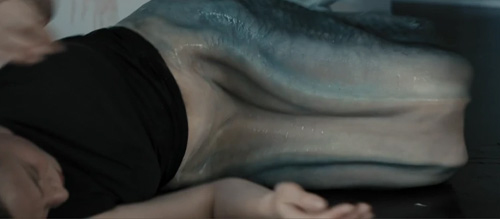
There is only one option left for Mia, to return to her true home. As the pair make their way to the beach they refuse to wallow in their approaching loss of one another’s company. Gianna tightly embraces Mia, before watching her leave life in search of true comfort. The character of the mermaid can be seen as a rich symbol of purity, swaying in and out of peaceful waves, listening to echoed splashes, and being entirely free to enjoy solitude.
The reckless purgatory surveyed in the likes of Carrie cements a damaging ideology that female change, especially in a monstrous structure, inevitably acts as a death wish that haunts the young woman at hand until she eventually erupts with catastrophic results. Blue My Mind rather cathartically redefines this old-fashioned filmic logic and the rulings of the monstrous feminine by removing Mia’s ‘could-be’ aggressive triggers in place of deflecting all of her vexation and confusion over her bodily disfigurations inwards. This result may temporarily cause an inner battle with the self, and it may evoke her self-destructive ways, but the change primarily prompts Mia to conjure a much more truthful war that translates to reality, both blurring the border between screen and real life, and forcing the viewer to take the emotive basis of Mia’s experiences and relate it to their own. Whilst Blue My Mind’s fantastical mermaid narrative acts as visual dynamite for the screen, the film’s undertones of feeling all alone in a world of uncertainty is a genuinely touching alignment to the self, where a solidified message of understanding is emitted from the film, akin to a token of sympathy calling for a needed change in the representation of the teenage girl.
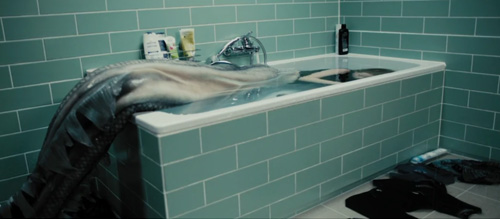
Every individual is entitled to their own unique journey no matter how alternative it may be to societal opinions. This debate all links back to what the monstrous feminine says about a greater issue. The monster may frighten and stir a response of fear, but further down the theory works as a commentary on the harsh judgement felt by women who are told how they should act, and the result (transforming into a full monstrous form) if they go against the societal grain and act on their taboos. In the contextualisation of Blue My Mind, Brühlmann recruits another version of the monstrous tactics different from Excision, Teeth, and Jennifer’s Body, by connecting Mia to high power greater than what any accustomed human may comprehend. Her crossing to another plane embodies a serenity that is denied to many. The young woman is a currency within horror, her natural urges encourage her to transform into whatever creature lies below, whilst also being told to not react or create damage. In turn, the rhythm of regulations is impossible to decipher, let alone actually participate in. Blue My Mind joins the likes of modern female-headed horrors such as In My Skin (2002), American Mary (2012), A Girl Walks Home Alone at Night (2014), Prevenge (2016), The Love Witch (2016), and Revenge (2017), to tackle the discriminative pathology of women’s portrayal in horror.
The blossoming teenager is primarily linked to vengeance, wanting to sink her teeth into vile men in an act of both erotic frustration and relief, thrusting a blood-hungry narrative into the forefront. Blue My Mind is a cooling cloth to this heated subgenre. When Mia says her goodbyes to Gianna the empty ocean is framed with rocky mountains on both sides, embodying a phallic visual of a birthing canal belonging to the body of water in which Mia is eventually reborn. Her journey into the water is symbolic of her going down the canal and back into the womb, leaving the life she was destined to succumb to. This path of transgression had no victims and there was no motive of pain to anyone but herself. Mia’s decision to make peace with her monstrousness follows a terrain not typically seen by mainstream cinema in which the female monster refuses to scald the masses and demolish her environment. Instead, Mia decides to swim away from what is expected of her. Blue My Mind aids in the reclaiming of what it means to be a monstrous teenage girl, generating a sense of ambiguity and a push towards an exciting and refreshing new window of coming-of-age horror.
Written by Grace Britten
You can support Grace Britten in the following places:
Blog – Film9Online
Instagram – @film_overload_

